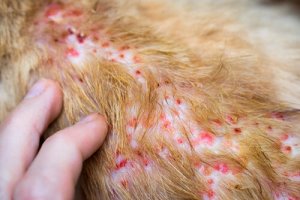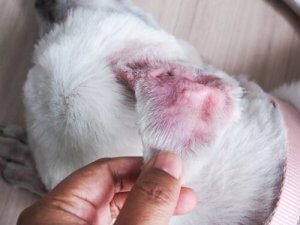Treatment for Atopic Dermatitis in Dogs


Written and verified by the biologist Ana Díaz Maqueda
Allergic dermatitis or canine atopic dermatitis is an inflammatory disease that causes intense itching. Genetic factors often play an important role. Today, about 10% of dogs suffer from this kind of dermatitis, although that number is steadily rising. It can also affect humans.
Atopic dermatitis is more commonly the result of an increase in immunoglobulin E (IgE) than contact with environmental allergens. However, there are other immune factors associated with this condition. What’s more, this type of dermatitis can lead to a number of secondary issues. As a result, there are several different treatment options available.
Treating infections
Atopic dermatitis in dogs can cause secondary infections in the damaged skin. The skin is naturally covered in bacterial flora which help to prevent harmful pathogens from colonizing on the skin’s surface. When the tissue is damaged, these harmful bacteria start to multiply, causing serious skin infections such as staphylococci and a fungus known as Malassezia.
These types of infections are treated with broad-spectrum antibiotics, whether oral or topical. Antifungal treatments will also be necessary to combat fungi.
Treating flea allergy dermatitis
Dogs that suffer from atopic dermatitis are more likely to develop flea allergy dermatitis. In these cases, the first thing you should do is treat for parasites, using a trusted brand that can eliminate them completely.

Treating atopic dermatitis – diet management
In many cases, the allergen can be a certain type of food or a specific ingredient in dog food. In this case, you’ll need to start your pet on an elimination diet to determine exactly what it’s allergic to.
On the other hand, hypoallergenic pet foods can also be useful in this situation. In most cases, however, these allergies are caused by highly processed foods, which often include ingredients not specified on the packet. As a result, it’s best to use 100% natural products in the elimination diet.
Treating seborrheic keratosis
Seborrheic keratosis is a keratinization disorder. The sebaceous glands produce an excessive amount of sebum, blocking the glands and causing dry, flaky skin. This is a common symptom of allergic dermatitis in dogs, especially in chronic cases. The treatment involves using oral fatty acid supplements and medicated shampoos.
Treating otitis externa
Otitis externa is one of the most common secondary conditions caused by allergic dermatitis in dogs. It usually manifests as an inflammation of the external auditory canal and outer ear. The animal may also develop bacterial and fungal infections. Excessive secretions from the ear may lead to chronic otitis.

Treating atopic dermatitis in dogs
The first step is to prevent the dog from coming into contact with the substance causing the allergy. To do this, a vet will perform an intradermal test to see which substances the skin reacts to. Dogs are often allergic to dust mites, so experts recommend cleaning the home with an acaricidal vacuum, and getting rid of any fabrics that could attract mites.
Alternatively, there are also immunotherapy treatments. These drugs mediate the body’s immune response, controlling T lymphocytes and E immunoglobulin, among other things.
Using glucocorticoids to treat atopic dermatitis in dogs
Corticosteroids are very effective drugs that help to eliminate the symptoms of canine atopic dermatitis. However, they don’t cure the disease itself, they only mask it. As a result, the dog won’t suffer from any painful itching or swelling of the skin, preventing the appearance of any secondary conditions. However, these drugs aren’t a long-term solution, so it’s important to look for alternative forms of therapy.
Allergic dermatitis or canine atopic dermatitis is an inflammatory disease that causes intense itching. Genetic factors often play an important role. Today, about 10% of dogs suffer from this kind of dermatitis, although that number is steadily rising. It can also affect humans.
Atopic dermatitis is more commonly the result of an increase in immunoglobulin E (IgE) than contact with environmental allergens. However, there are other immune factors associated with this condition. What’s more, this type of dermatitis can lead to a number of secondary issues. As a result, there are several different treatment options available.
Treating infections
Atopic dermatitis in dogs can cause secondary infections in the damaged skin. The skin is naturally covered in bacterial flora which help to prevent harmful pathogens from colonizing on the skin’s surface. When the tissue is damaged, these harmful bacteria start to multiply, causing serious skin infections such as staphylococci and a fungus known as Malassezia.
These types of infections are treated with broad-spectrum antibiotics, whether oral or topical. Antifungal treatments will also be necessary to combat fungi.
Treating flea allergy dermatitis
Dogs that suffer from atopic dermatitis are more likely to develop flea allergy dermatitis. In these cases, the first thing you should do is treat for parasites, using a trusted brand that can eliminate them completely.

Treating atopic dermatitis – diet management
In many cases, the allergen can be a certain type of food or a specific ingredient in dog food. In this case, you’ll need to start your pet on an elimination diet to determine exactly what it’s allergic to.
On the other hand, hypoallergenic pet foods can also be useful in this situation. In most cases, however, these allergies are caused by highly processed foods, which often include ingredients not specified on the packet. As a result, it’s best to use 100% natural products in the elimination diet.
Treating seborrheic keratosis
Seborrheic keratosis is a keratinization disorder. The sebaceous glands produce an excessive amount of sebum, blocking the glands and causing dry, flaky skin. This is a common symptom of allergic dermatitis in dogs, especially in chronic cases. The treatment involves using oral fatty acid supplements and medicated shampoos.
Treating otitis externa
Otitis externa is one of the most common secondary conditions caused by allergic dermatitis in dogs. It usually manifests as an inflammation of the external auditory canal and outer ear. The animal may also develop bacterial and fungal infections. Excessive secretions from the ear may lead to chronic otitis.

Treating atopic dermatitis in dogs
The first step is to prevent the dog from coming into contact with the substance causing the allergy. To do this, a vet will perform an intradermal test to see which substances the skin reacts to. Dogs are often allergic to dust mites, so experts recommend cleaning the home with an acaricidal vacuum, and getting rid of any fabrics that could attract mites.
Alternatively, there are also immunotherapy treatments. These drugs mediate the body’s immune response, controlling T lymphocytes and E immunoglobulin, among other things.
Using glucocorticoids to treat atopic dermatitis in dogs
Corticosteroids are very effective drugs that help to eliminate the symptoms of canine atopic dermatitis. However, they don’t cure the disease itself, they only mask it. As a result, the dog won’t suffer from any painful itching or swelling of the skin, preventing the appearance of any secondary conditions. However, these drugs aren’t a long-term solution, so it’s important to look for alternative forms of therapy.
All cited sources were thoroughly reviewed by our team to ensure their quality, reliability, currency, and validity. The bibliography of this article was considered reliable and of academic or scientific accuracy.
- Barboza, G., Villalobos, A., Fernández, G., Bracho, J. S., Ramirez, R., & García, G. (2001). Dermatitis alergica en caninos. Estudio clinico dermatologico en 54 perros realizado en la Policlinica Veterinaria de la Universidad del Zulia. Revista Científica de la Facultad de Ciencias Veterinarias, 11(4), 329-337.
- Carlotti, D. N. (2011). Dermatitis atópica canina; nuevos conceptos (etiología, patogenia, cuadro clínico, diagnóstico y tratamiento).
- Navarro, L., & Verde Arribas, M. T. (2002). La dermatitis alérgica a la picadura de pulga. Clínica veterinaria de pequeños animales, 22(4), 0311-317.
This text is provided for informational purposes only and does not replace consultation with a professional. If in doubt, consult your specialist.








